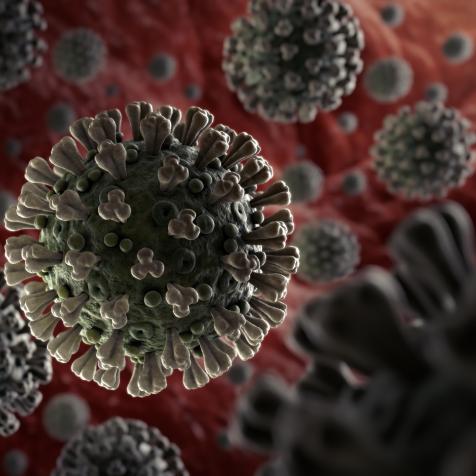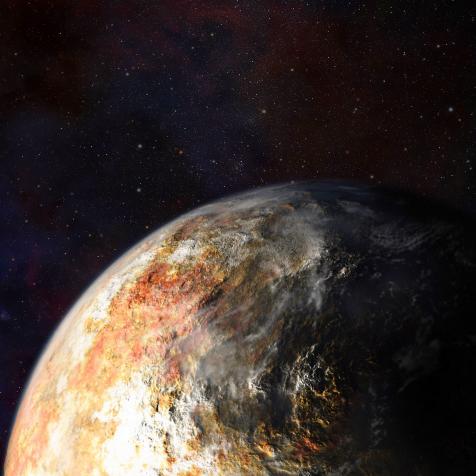
Shutterstock
The Stupidly Dangerous Chemical Chlorine Trifluoride Can Make Anything Burst Into Flames on Contact
This liquid chemical is so corrosive that it can virtually burn through anything.
A little bit of danger can be exciting. But if you start talkin' chlorine trifluoride, we'll take a hard pass, thanks. This liquid chemical is so corrosive that it can make practically anything burst into flames on contact. We're pretty sure the compound's common name is "NOPE."
Don't Try This at Home
Fluorine is known as the most powerful oxidizing agent out of all the elements — in fact, it's so reactive that it turns water into oxygen on contact. That makes it pretty much impossible to store in solution. In the 1930s, scientists Otto Ruff and H. Krug set out to find something easier to handle, but just as reactive. They isolated the compound chlorine trifluoride (ClF3), which was liquid (check!) and even more reactive than fluorine (double check!). It's just that it may have been a bit too reactive. Sprinkling this chemical on virtually any other thing will start a fire that cannot be extinguished. Or an explosion. Pick whichever route you prefer.
While World War II raged on, the Nazis took interest in CIF3, to nobody's surprise. The stuff could be used as an incredibly effective chemical weapon that was also cheap to produce. In particular, CIF3 would make for perfectly destructive flamethrowers and bombs. They started churning the stuff out by the tons before deciding it was far too unstable and reactive to handle. Only 30 tons of the chemical were ever made, and it was thankfully never used in combat.
Makes sense, seeing as the only known "safe" way to store CIF3 is to seal it in containers made of steel, iron, nickel, or copper after they've been treated with fluorine gas. This creates a thin fluoride layer inside the container, which won't disturb the CIF3. If it's not perfectly treated, then kaboom goes the vessel. But we don't really have to worry about that too much. Since the war, the compound has been banned under the Chemical Weapons Convention.
It's the Remix to Ignition
To understand why chlorine trifluoride is top of the "avoid at all costs" list, let's rewind to the oxidizing agent part. Oxidizing agents cause substances to lose electrons. Oxygen, hydrogen peroxide, and the halogens are common examples of these agents. CIF3 is an effective oxidizer, one that's arguably too effective. It's been used in the semiconductor industry to clean oxides off of surfaces, but, in general, it's probably too powerful for its own good. CIF3 oxidizes so well that it can ignite things that are otherwise fireproof, even famously flame-retardant asbestos.
To illustrate its terribly violent power, take this example from the 1950s. A ton of CIF3 was accidentally spilled on a warehouse floor, which caused it to burn straight through a foot (30 centimeters) of concrete and three feet (90 centimeters) of gravel. Oh, and in the process, it also released hot, deadly clouds of hydrofluoric acid that corroded everything in its path. There was no way to extinguish it, either. Pouring water (or anything else) on it only fuels the flames in an explosive way. You just have to wait for it to do its thing.
Chemist John D. Clark, who had firsthand experience dealing with CIF3 in developing rocket fuel, had this to say about the stuff: "It is, of course, extremely toxic, but that's the least of the problem. It is hypergolic with" (that is, it explodes in contact with) "every known fuel, and so rapidly hypergolic that no ignition delay has ever been measured. It is also hypergolic with such things as cloth, wood, and test engineers, not to mention asbestos, sand, and water — with which it reacts explosively.
"It can be kept in some of the ordinary structural metals — steel, copper, aluminium, etc. — because of the formation of a thin film of insoluble metal fluoride which protects the bulk of the metal, just as the invisible coat of oxide on aluminium keeps it from burning up in the atmosphere. If, however, this coat is melted or scrubbed off, and has no chance to reform, the operator is confronted with the problem of coping with a metal-fluorine fire. For dealing with this situation, I have always recommended a good pair of running shoes."
This article first appeared on Curiosity.com.





















